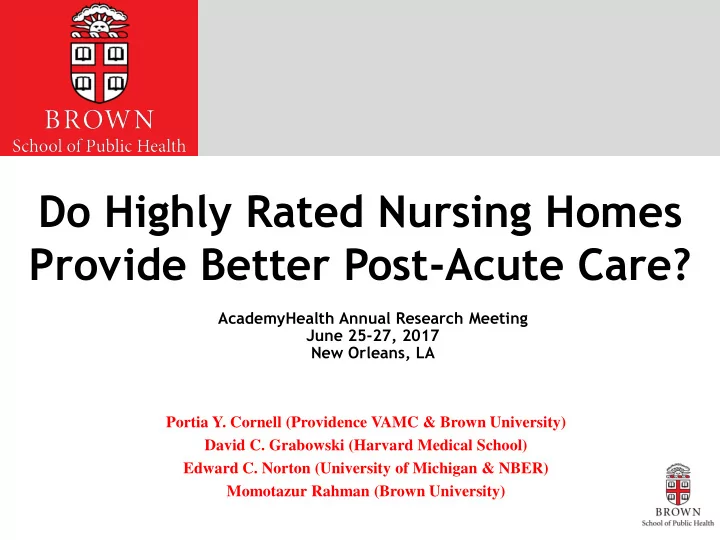

Do Highly Rated Nursing Homes Provide Better Post-Acute Care? AcademyHealth Annual Research Meeting June 25-27, 2017 New Orleans, LA Portia Y. Cornell (Providence VAMC & Brown University) David C. Grabowski (Harvard Medical School) Edward C. Norton (University of Michigan & NBER) Momotazur Rahman (Brown University)
Background In 2008, CMS adopted a five-star quality rating system for SNFs in an effort to improve quality of care by informing consumer choices. A number of concerns about the 5-star rating system remain awareness and mistrust of the data limiting consumers use of the rating system whether the “one size fits all” approach of the star rating system gives relevant in fomration to the many different types of patients seeking nursing home care whether choosing a highly rated SNF improves patient outcomes is unknown 2
Patient and nursing-home data Medicare: inpatient and post-acute claims, dates of service, diagnoses Minimum Data Set (MDS): clinical assessments Online Survey Certification and Reporting (OSCAR) American Hospital Association (AHA) Monthly Star rating from Nursing Home Compare 1,303,484 FFS patients from 3,173 hospitals discharged to 14,750 SNFs 3
Outcome measure Follow patients for 180 days after admission to SNF Assigned each day to one of 6 settings Mean number of Std. Dev. days Death 25.04 52.88 Hospice 3.69 17.26 Hospital 5.48 10.96 Skilled nursing facility 48.24 49.22 Home with home health 28.33 38.08 Home without home health 70.21 64.14 4
Patient-level controls Demographics: age, sex, language, race, ethnicity, marital status, dual-eligible Utilization: intensive care, coronary care, length of stay Health status: functional/cognitive scales, diagnoses 5
Reduced-form equation Y izhtn • Outcome: Number of days in a setting out of � 180 Q int • Overall Star rating, integer 1 - 5 � X i • Patient characteristics � q t • Time fixed effects � z z • ZIP code fixed effects � 6
Selection bias Causal effect of star rating on patient outcomes difficult to parse Hospitals send highest-risk patients to best nursing homes Case Mix Patients who use quality ratings may be systematically 7 different
Distance as instrumental variable Patients tend to choose a nursing home close to home Within a zip code, quality of closest nursing home can change month to month, or with market exit/entry Zip code fixed effects control for geographic characteristics correlated with star rating 8
Strength of first stage Log of distance to Effect on Q, star rating of The further away the nearest SNF admitting nursing home nearest 1-star, the higher rating the quality rating 0.0683*** 1-star 0.0633*** 2-star Monotonic effect 0.0101*** 3-star from 1-star to 5-star -0.0804*** 4-star -0.121*** 5-star The further away the nearest 5-star, the lower 0.262 R-squared the quality rating 2612.3 F-statistic 9
Main IV Results IV estimate with ZIP Percent change from Outcome Mean fixed effects mean -1.440*** -1.440*** -6.0% Death days [-3.711] [-3.711] -0.0951 -0.0951 -0.0% Hospice days [-0.691] [-0.691] Hospital inpatient -0.182** -0.182** -3.6% days [-2.195] [-2.195] -1.139*** -1.139*** -2.3% Nursing home days [-3.001] [-3.001] 1.124*** 1.124*** +3.9% Home health days [3.731] [3.731] 1.732*** 1.732*** +2.4% Home days [4.027] [4.027] (t-statistics in parentheses) (t-statistics in parentheses) 10
Instrumented vs. OLS 11
Full IV Results Hospital and zip Hospital fixed Zip code fixed Outcome No fixed effects code fixed effects effects effects -1.704*** -1.060*** -1.440*** -1.476*** Death days [-17.23] [-5.172] [-3.711] [-3.785] -0.00812 0.0216 -0.0951 -0.0811 Hospice days [-0.234] [0.296] [-0.691] [-0.586] -0.262*** -0.229*** -0.182** -0.189** Inpatient days [-12.20] [-5.032] [-2.195] [-2.260] -1.661*** 0.617*** -1.139*** -1.070*** Nursing home days [-16.69] [3.032] [-3.001] [-2.824] -1.262*** -0.621*** 1.124*** 1.143*** Home health days [-16.07] [-3.915] [3.731] [3.785] 4.898*** 1.273*** 1.732*** 1.672*** Home days [43.41] [5.517] [4.027] [3.888] Without FE and only hospital FE closer to OLS ZIP-FE similar with and without hospital FE 12
Results by day Estimate probability of being in a particular setting of each of 180 days Effects persist over time, not just in initial days after admission 13
Results by day 14
Summary Patients who go to higher-rated SNFs spent more time in better outcomes and less time in worse outcomes. OLS underestimates the mortality and hospital in effect and overestimates the effect on days at home 15
Discussion Controlling for endogeneity of selection matters Validates star rating as meaningful for patients looking for care 16
Recommend
More recommend